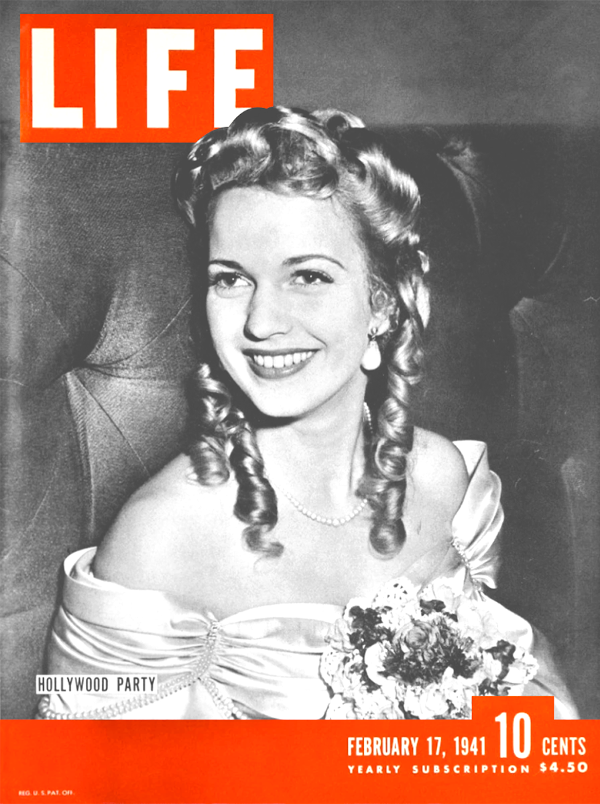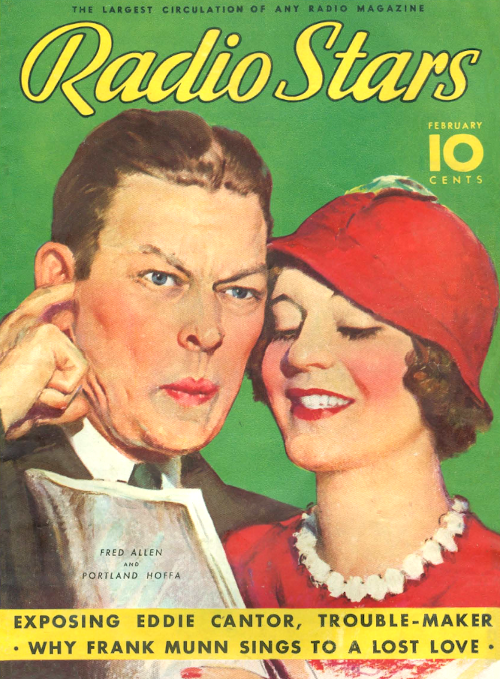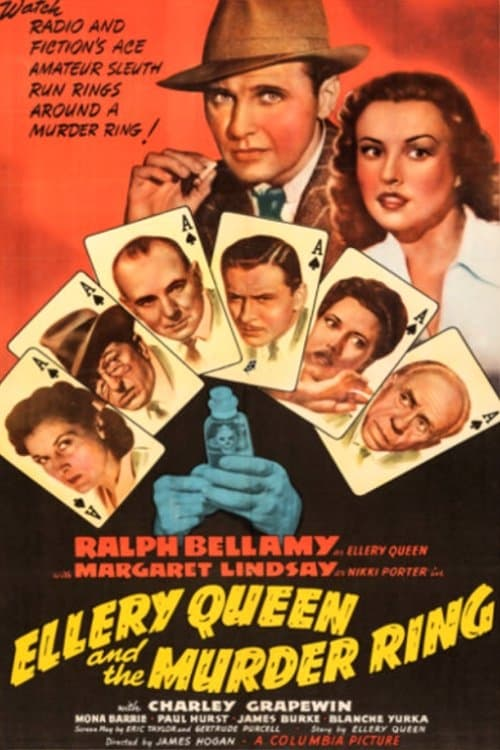Cobina Wright Jr. Makes Radio Singing Debut at 17

At 17, attractive Cobina Wright, Jr., isn't the least bit worried by microphones. In fact, says she, "I love 'em."
And she speaks from a wealth of experience, for the blond and beautiful daughter of an equally well-known mother has appeared before some of the nation's best mikes. These ventures into radiodom include guest appearances on We, the People, with Eddie Cantor's Camel Caravan, Consolidated Edison's City of Light, and the True Story hour, not to overlook a recent fling into the mystic realms of television.
Cobina Jr., is pretty enthusiastic about broadcasting. "I like it because you can do so very much more in front of a microphone," she declared, opening her blue eyes wide with sincerity. "Radio reaches so awfully many people. I think broadcasting is one of the most fascinating things I've ever tried."
The young lady, as you probably know, is the talented protege of her astute mother who, after seeing the Wright fortunes collapse in the general melee of 1929, set out anew to restore the social and financial status of both Cobinas by a vigorous application of wits, talent and good business sense. She did it.
High-pressured to the ranks of the glamour girls, Cobina Jr. is tallish and slim, with trimly formed features and a wealth of blond hair. Despite her seventeen years, she possesses the poise and mannerisms of a maturer woman, tinged occasionally by some girlish inflection or gesture. Product of her patrician mother's tutelage, she aspires to a continued career before the microphone and on the stage. Like Brenda Diana Duff Frazier, with whom she went to school, Cobina Wright Jr.'s name has today become nationally synonymous with the term "glamour girl."
One of the features of guest broadcasting which she finds particularly appealing is the colorful tempo of the studios. "Things are at such tension all the time," she exclaimed. "That's what I like best. You sit there, waiting for airtime, and the little second hand on the clock just creeps around and around until suddenly -- you're on the air. Also, you can never tell when somebody is going to tiptoe up behind you and cut out or change part of your script to make it longer or shorter -- right on the air, too!" Her eyes opened wide again at this almost unbelievable phenomenon.
Cobina Jr. recalls vividly the ordeal she once went through just before her guest appearance on Columbia's We, the People. There had been a mix-up over arrangements for her scheduled song, and the one she planned to use was somehow mislaid . Minutes were precious, so slim Cobina sang her way through "All Yours" minus orchestral accompaniment while Mark Warnow and his band listened with an attentive ear. Then, instrument by instrument, the orchestra picked up the tune to match Cobina's arrangement. That night no one beyond the shiny walls of the studio noticed the slightest imperfection in either music or Cobina's own flawless voice.
She thinks her love of radio dates back to her own impromptu air debut at the age of fourteen. (If anybody doesn't believe Cobina is only 17, challenges Cobina Wright Sr., they can look it up in the records of the New York Hospital.) This debut was at the Hotel Ambassador and -- oddly enough -- also with Mark Warnow. Mrs. Wright, once an opera singer of note, was a vocalist. and so introduced Cobina Jr. without fanfare. She merely marched up in front of the orchestra to that intriguing microphone and sang "Love on a Dime."
Everyone applauded enthusiastically. They didn't know, however, that it was the first time this young girl had ever sung with an orchestra or before so many people. Listeners heard her over the air, wrote glowing letters. Mrs.Wright, who has taught her daughter all that she knows about music, glimpsed the beginnings of a possible career for Cobina Jr. Engagements followed at Palm Beach, Boston and back again in New York. The young lady, however, will not sing in any nightclubs. That was settled long ago. Right now mother and daughter are working on a joint radio program which they hope to offer over a nationwide network next fall.
Eddie Cantor has done much for Cobina Jr., inviting her frequently to share his microphone. Only sometimes, in spontaneous Cantor style, he shifts lines on her so that the show doesn't exactly follow the rehearsed script. "It keeps me on my toes," she explained, "but I guess that's good for me if I'm ever going to make an attempt at a stage career."
Cobina Jr never tells her friends to listen when she's slated for a guest appearance. "1 don't know why that is," she confessed, "unless maybe I'm superstitious. I'm afraid that if everybody tunes in perhaps I'll make a mistake or something. Anyhow, I never lell them to listen. I just hope that they will."
Dick Dorrance in Radio Guide, August 1939
Ray Starita and His Ambassadors Band - Blue River (1938)
Ray Starita and His Ambassadors Band recorded the song "Blue River" with Eddie Collins on vocals in London on April 5, 1938, for the Columbia label. The performers were Starita, who played clarinet and tenor sax and directed the band, Andy Richardson and Sylvester Ahola on trumpet, Bill Hall on trombone, Chester Smith on alto sax, Reg Pursglove on violin, Donald Thorne on piano, Jack Hill on guitar, Arthur Calkin on brass bass and Rudy Starita on drums and vibes.
Ray Starita was a British dance band leader and reed player who was born in Sicily and grew up in the United States. He performed in London from 1925 to 1932, then returned to the United States and operated an amusement park.
"Blue River" is a song first recorded in July 1927 by either the Original Dixie Rag Pickers or The Harmonizers. The music was written by Joseph Meyer and lyrics by Al Bryan. Meyer also wrote the songs "California, Here I Come" and "If You Knew Susie."
What's in a Name? A Lot in Portland Hoffa's Family

When Fred Allen met Portland Hoffa on the vaudeville circuit in 1922, he was telling jokes and performing badly as a juggler. She was a dancer. The two future comedy stars hit it off because of a conversation about her name:
"I'm a doctor's daughter," Hoffa advised him. "My father named me after the city where I was born. Out in Oregon, you know."
"I know," said Allen. ''You ought to be glad you weren't born in Terre Haute or Gila Bend or Hastings-on-the- Hudson."
"One of my sisters was called Lebanon and another Last One," said Hoffa.
"Good gracious."
"Dad thought she'd be the last one," Hoffa continued serenely, "but she wasn't. So he changed her name to Next-to-Last."
This story is mostly true. Portland Hoffa was born in Portland, Maine, and had a sister named Lebanon (of Pennsylvania) and brother named Harlem (New York City). There also was a sister named Last One. She wasn't last after all and the next and final child was named Period, but went by the nickname Baby.
One Hoffa child eluded location-based naming and was called Fredericka after their father Frederick, a traveling optometrist.
In 1966, the actress Jessica Walter had to be rescued when a fire broke out in her 10th floor apartment in New York City. A firefighter checked on the occupant of the apartment one floor below, as the syndicated newspaper columnist Leonard Lyon wrote in the Oakland Tribune of October 10:
He asked her name. "Mrs. Hershkowitz," she said. "First name? "Last One." The fireman asked her to repeat it. "Last One," she said. Her parents had chosen odd names for all their children. Her sister, Portland, married Fred Allen. Another sister was named Lebanon, another one Period, a brother was named Harlem.
Mrs. Hershkowitz began to spell "Last One." The fireman said, "Never mind. What's your husband's first name?"
Book Covers the Years Ellery Queen Fought Crime on Radio

Martin Grams Jr. has gained the reputation of being somewhat of a research dynamo. Rarely will you speak to Grams when he's not engrossed in researching a particular show for an article, a book or simply for the sake of knowing more about it. He's gotten the reputation of being one of the most productive old time radio scholars today.
For his latest book, The Sounds of Detection: Ellery Queen's Adventures in Radio, Grams teamed up with Francis M. Nevins. Francis is an accomplished mystery writer himself and has also written non-fiction books on the subjects of Cornell Woolrich, Hopalong Cassidy and (ironically enough) Ellery Queen. Obviously, this multiple Edgar Award winner (Nevins) and this Ray Stanich Award winner (Grams) make for a fine teaming for the authorship of this book.
Nevins tackles what he knows best: the history of Queen in print, radio and film. He left the task of creating a thorough and comprehensive log of the show's nine-year-run to Grams, a task that he obviously tackled with great gusto. The long is one of the most comprehensive and informative logs that have been published yet, and the introduction to the show and its authors reads in a breezy, informal manner. It's a treat from start to finish, and this comes from a person who has never heard the Queen show or read one of the books.
To further flesh out the impact of the show we're treated to additional essays by Anthony Boucher and William Nadel. We get short biographies of each guest of the show, and as a special treat, a forward written by the late Larry Dobkin, who played Queen on radio for a short time (in addition to other roles on radio which must number over a thousand).
If you're a fan of the Queen novels or are interested in the radio program, The Sound of Detection is well worth having. The amount of research and knowledge on the part of the authors shines through on every page.
Rodney Bowcock Jr. in Old Time Radio Digest, Winter 2003
Maryland Dance Orchestra - How I Love That Girl (1924)
The Maryland Dance Orchestra recorded the song "How I Love That Girl" in New York in November 1924 for the Coliseum label. The performers were Ben Bernie and His Orchestra, featuring Donald Bryan and Harold Rehrig on trumpet; Frank Sarlo on trombone; Mickey McCullough, Len Kavash and Jack Pettis on reeds; Al Goering and J "Kenn" Sisson on piano; Paul Nito on banjo and violin; Al Armer on brass bass; Sam Fink on drums; and Irving Kaufman on vocals.
Ben Bernie, whose real name was Benjamin Anzelwitz, was a popular bandleader, jazz violinist and radio host. In the 1920s he formed a band, The Lads, that included Oscar Levant on piano. His orchestra performed in the first NBC radio broadcast on November 15, 1926, and he went on to success hosting musical variety shows such as Ben Bernie, The Old Maestro in the 1930s. The show's announcer was Jimmy Wallington.
"How I Love That Girl" is a 1924 foxtrot with lyrics by Gus Kahn and music by Ted Fiorito. Fiorito was a bandleader who also collaborated with Kahn on the songs "Eliza," "No No Nora," and "When Lights are Low." Kahn's classic songs include "It Had to Be You," "Yes, Sir, That's My Baby," and "Toot, Toot, Tootsie, Goodbye."
Betsy King, the Youngest Disc Jockey on Radio
Radio's newest program type to run the gamut and come through a success is the kid disc jockey. The latest is Betsy King, daughter of Gene King, program director of WCOP, Boston. Betsy handles a much longer session than most of the disc jockeys who have to sit on phone books to cue up discs. She handles the program as though it were two half-hours from 9 a.m. to 10 a.m. She calls her hour Let's Have Fun, and she does.
Because she feels that Sundays must have prayers, she ends each session with a prayer -- one of her own -- and sends her listeners off to church. The reason she has planned her program as two half-hours is a religious one, also. She feels that the first group of listeners start for church on the half hour and that the second has returned home from earlier services.
One reason why it's possible to have a disc jockey session for the youngsters is because today there's a wealth of recorded music, nursery rhymes and stores especially pressed for the just-out-of-diapers trade. Whereas a year ago a disc jockey like Betsy King would have run out of discs to play in a very few weeks, today there are literally thousands of recordings which are not only entertaining for the youngsters but have the approval of the PTAs and educators generally. When there are plenty of discs to spin, it's logical that there will be a solid increase in jockeys to spin them.
Betsy King's appearance on the air was an accident. ABC cancelled Coast-to-Coast on a Bus, a network program with a big following in Boston. WCOP wanted to hold that audience and decided to replace the network program with one of its own that had the same basic appeal. It was one thing to make this decision, and still another to create a program that would hold the critical young audience.
Practically all the children who auditioned for the program went stiff before the mike, and the station was about to forget the whole thing when Gene King finally sold Mrs. King on letting their daughter have a crack at it.
Although Gene is program director of the station, he is a disc jockey at heart. He held down the Midnight Jamboree at WEVD New York for a long time, and then moved to WOR for an afternoon period of record spinning.
Eight-year-old Betsy had grown up in a show business disc jockey atmosphere, and when she sat down to play records and talk about them, it was just as though she were mimicking Daddy. She doesn't go to the studio, she goes to Daddy's office. That doesn't change the fact that she feels she has a responsibility to "her audience." She has to earn the dime a week her stint pays her -- the rest goes into a bank account about which she knows nothing.
Recently Betsy offered 100 sundial watches to the first 100 writers of letters to her program. She received 2,655 requests from 145 different communities. The cards and letters were not only bids for the watch, but also included requests for favorite discs like "I Luv a Wabbitt," "Mickey and the Beanstalk," and Betsy's theme song, "Peter, Peter, Pumpkin Eater."
Betsy insisted on checking each postmark on the letters to make certain that the first 100 writers received their watches. To the rest she insisted on writing letters telling them that she was sorry there weren't enough watches to go around. "After all," she explained to Daddy, "I can't afford to lose all my listeners."
It's Betsy's unspoiled quality, plus the extensive collection of discs from which she can choose records to spin, that has given her a higher rating than Coast-to-Coast on a Bus was receiving when it went off the air. It's only a Pulse of 4.3, but that's slightly terrific for Sundays at 9 a.m.
While giving tiny Betsy a great deal of credit, it's also wise to keep in mind that her scripts are written by her program director father. Also, Betsy rehearses. What she does comes naturally, but the reason that she's such a success is because even at eight, she's a performer.
There's an extra factor. Dad has never forgotten that it takes promotion to build even a kid session. Burl Ives crowned Betsy "Queen of the AFRA Ball" in Boston, and that too was part of what it takes in show business, on or off radio. The program hit the air for the first time last November, and it's growing in impact practically broadcast by broadcast.
From Sponsor, June 20, 1949
Piccadilly Dance Band (Allan Selby) - Kitty's Kisses (1928)
The Piccadilly Dance Band recorded the song "Kitty's Kisses" in London for Piccadilly Records in August 1928. The recording was directed by Allan Selby and includes Phil Lever on trumpet; L. Cooper on trombone; Sid Lenton and H. Brooks on reeds; Bobby Davis on piano; Hal Pike on banjo; R. del Perugia on brass bass; and G. Marshall on drums.
"Kitty's Kisses" was the title song from a 1926 summer musical that faded to obscurity until its music was rereleased by PS Classics in 2009. The music was by Con Conrad, lyrics by Gus Kahn and the theater book was coauthored by Otto Harbach.
Top 10 Articles
- The Marriage of Don Ameche and Honore Prendergast
- The Night Arthur Godfrey Fired a Singer On Live Radio
- Early Radio Announcers Invented Their Profession in the 1920s
- The Mythical Town of East Tincup, Colorado
- The Earliest Radio Shows of the 1920s
- The Great Radio Detectives of the 1950s
- The Home Life of Jack Benny
- Why Vladimir Horowitz Stopped Performing in the 1930s
- Judy Canova: The Queen of Hillbilly Hokum
- Some of the Unsung Heroes of Radio

